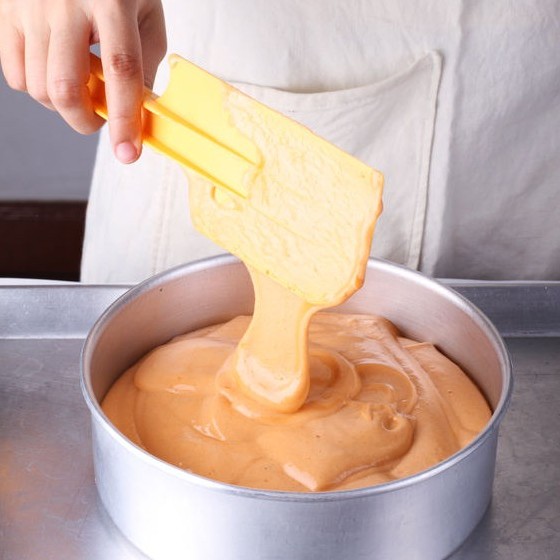
Viscosity
What is Viscosity?
Viscosity is the thickness or resistance to flow of a fluid. It is the measure of shear stress/shear rate. Shear stress is the force per unit area used to move a material.3 Shear rate is a measure of the change in speed at which the intermediate layers of a fluid move with respect to each other.3
A fluid with higher viscosity would pour slowly and seem thicker than a fluid with less viscosity. For example, water would have a lower viscosity than cake batter. Centipoise (cP) is the standard unit of measure for viscosity in the USA. MilliPascal*seconds is the common unit in other countries.
1cP = 1mPa*s.
Newtonian vs. Non-Newtonian Fluids
Newtonian fluids do not change viscosity with shear. This means that a plot of shear stress versus shear rate at a given temperature is a straight line with a constant slope that is independent of the shear rate.2 Examples of Newtonian fluids are water, air, and ethanol.
A non-Newtonian fluid is any fluid that does not obey the Newtonian relationship between the shear stress and shear rate.2 Examples of non-Newtonian fluids are slurries, pastes and high molecular weight liquids.2 Non-Newtonian fluids can be categorized into five types based on the way a fluid’s viscosity changes in response to variations in shear rate.3
- Psuedoplastic: a material’s viscosity decreases as the shear rate increases. This type of flow behavior is sometimes called shear-thinning.1 Cake batter, agar-agar and fruit juice concentrates are examples of psuedoplastic foods.
- Dilatant: a material’s viscosity increases as the shear rate increases. This type of behavior is sometimes called shear-thickening. 3 Corn starch mixed with water and candy compounds are examples of dilatant foods.
- Plastic: a material appears to be solid until force is applied. Once force is applied the material will flow. Tomato catsup is a good example of this type fluid. Its yield value will often make it refuse to pour from the bottle until the bottle is shaken or struck, allowing the catsup to gush freely.3
- Thixotropy: a material’s viscosity decreases when sheared at a constant rate over time.1 Yogurt, pea protein and water, and honey are examples of thixotropic foods.
- Rheopexy: a material’s viscosity increases when sheared at a constant rate over time.1 Cream to whipped cream is an example of a rheopectic food.
How is Viscosity Measured?
Viscosity is measured with Viscometers, Rheometers, or Plastometers. Samples may be gathered during processing and lab tested by QA staff. Another option is an inline system allowing constant monitoring during production. It is important to remember a material’s viscosity is not a single point measurement, but often depends on a number of factors, like time and temperature.1 Small variations of processing conditions and raw materials can affect flow behavior and final viscosity.5
How Can Viscosity Impact Commercial Production
Understanding viscosity can allow you to determine the best process and equipment needed for commercial production of your product.5 For example, “the ability to characterize the pseudoplastic behavior of the batter can pay dividends in more ways than one. Processing the batter effectively in a production operation relates back to the viscosity issue. Thicker formulations are more difficult to move and handle in general. There may also be a correlation between the density of the baked product and the viscosity of the batter.
“Consequently, some major bakeries have progressed from making benchtop measurements with a rotational viscometer in the QC lab to using an on-line process viscometer which measures continuously as the batter is mixed and processed. The obvious advantage is the improved quality in batter consistency and potential cost savings in not reworking out of spec batches.”4
References
- McGregor, Robert. “Viscosity: The Basics.” Ed. Dorothy Lozowski. . Chemical Engineering. 1 Aug. 2009, pp. 34-39. www.chemengonline.com/viscosity-the-basics/?printmode=1 . Accessed 11 Jan. 2017.
- Subramanian, R. Shankar. “Non-Newtonian Flows.” Department of Chemical and Biomolecular Engineering, Clarkson University.(2002) http://people.clarkson.edu/projects/subramanian/ch301/notes/Non%20Newtonian%20Flows.pdf. Accessed 11 January 2017
- “What Is Viscosity.” Brookfield Ametek, www.brookfieldengineering.com/education/what-is-viscosity.asp#nonnewtonian. Accessed 12 Jan. 2017.
- McGregor, Robert. “Re: Viscosity” Received by Katie Jones, 2 Jan. 2017.
- Berta, Marco, Johan Wiklund, Reinhardt Kotzé, and Mats Stading. “Correlation between in-line measurements of tomato ketchup shear viscosity and extensional viscosity.” Journal of Food Engineering 173 (2016): 8-14.

